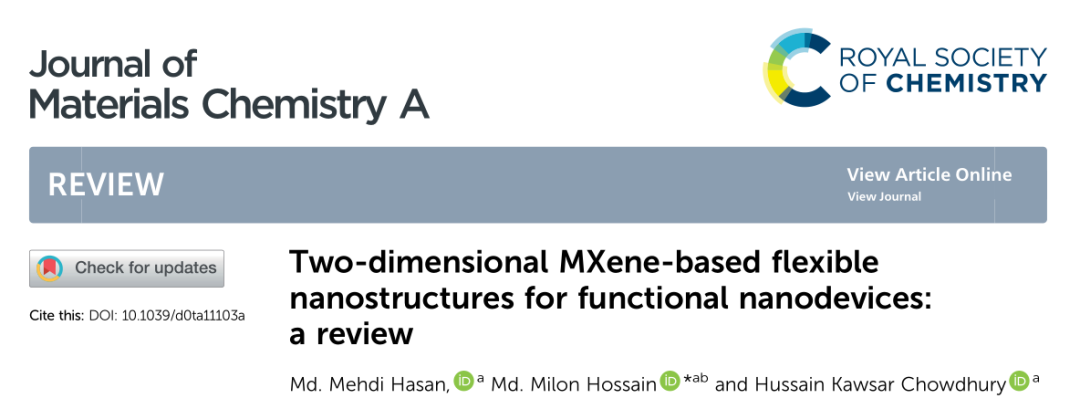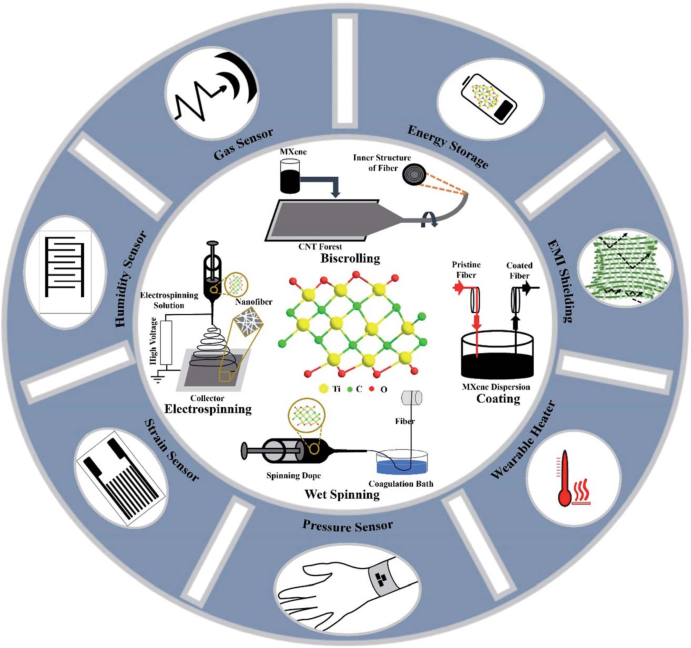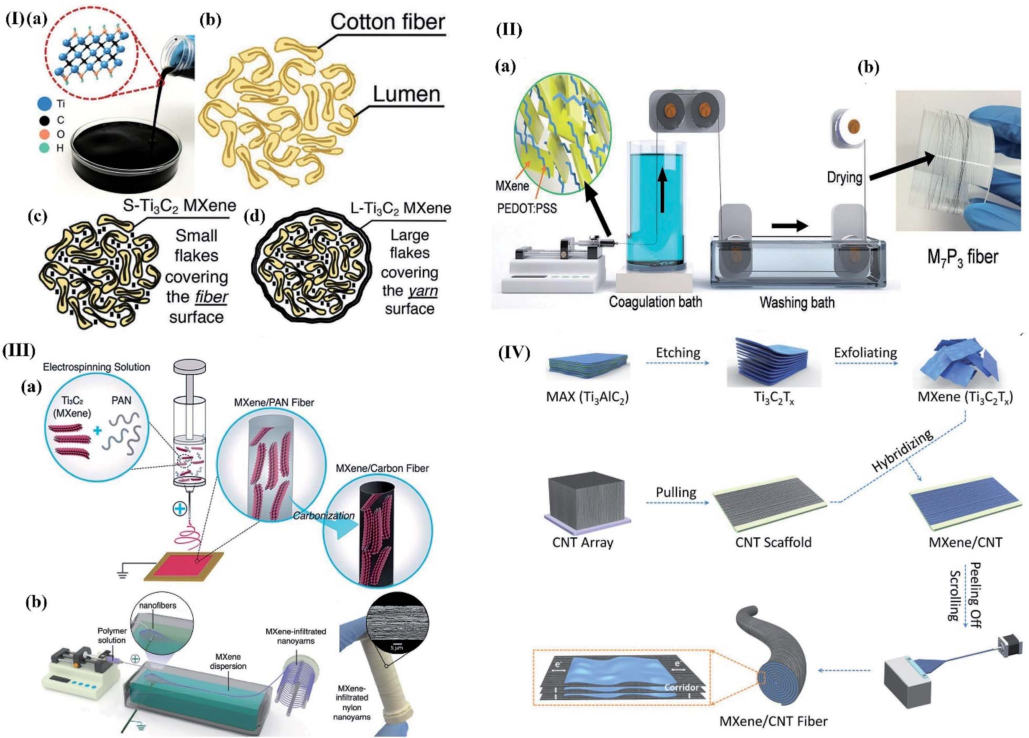
hotline:
17715390137
Tel/Wechat:
18101240246 (Technology)
0512-68565571
Email:mxenes@163.com (Sales Engineer)bkxc.bonnie@gmail.com
Scan the code to follow or search the official account on WeChat:
2D Materials Fronrier After paying attention,
click on the lower right corner to contact us,
Enter enterprise WeChat.
Professional Services Online

 In recent years, two-dimensional MXene has been extensively studied and more than 30 compositions have been discovered. The metal conductivity and pseudocapacitive behavior of MXenes proves its exciting potential in electrochemical energy storage and conversion, electromagnetic shielding, wearable sensors, and personal hyperthermia. Driven by surface terminating functional groups, general chemical methods and excellent solubility, MXenes has been integrated with various flexible and nanoporous substrates for wearable nanodevice applications. However, existing reviews mainly focus on different substrates for multifunctional applications. So far, there has not been a specific evaluation report on breathability and comfort for wearable nanodevices.
In recent years, two-dimensional MXene has been extensively studied and more than 30 compositions have been discovered. The metal conductivity and pseudocapacitive behavior of MXenes proves its exciting potential in electrochemical energy storage and conversion, electromagnetic shielding, wearable sensors, and personal hyperthermia. Driven by surface terminating functional groups, general chemical methods and excellent solubility, MXenes has been integrated with various flexible and nanoporous substrates for wearable nanodevice applications. However, existing reviews mainly focus on different substrates for multifunctional applications. So far, there has not been a specific evaluation report on breathability and comfort for wearable nanodevices.
Based on this, the scientific research team of Khulna University of Engineering and Technology in Bangladesh published a review article entitled "Two-dimensional MXene-based flexible nanostructures for functional nanodevices: a review" in the international journal Journal of Materials Chemistry A, and wrote A detailed evaluation report was issued.

In this review, the synthesis process and its influence on the performance of MXene, as well as the structure-property relationship of MXene are summarized. Comprehensively summarize and analyze the current progress of the MXene integration process. It also explored and evaluated energy harvesting and storage, electromagnetic shielding, Joule heating, and strain and pressure sensing applications. Provides a brief overview of humidity and gas sensing based on MXene nanostructures. In addition, the development of wearable nanodevices highlights the current challenges and prospects of these emerging fields.

Figure 1. MXene-based fiber substrate manufacturing methods (coating, wet spinning, double-roll and electrostatic spinning) and main applications (energy storage, sensors, electromagnetic interference shielding and wearable electric heaters).

Figure 2. Manufacturing process of MXene-based flexible nanostructures.
Although MXene performs better than some 2D materials in specific applications, several challenges still need to be solved to realize its practical applications. (1) Most reported MXene synthesis methods involve HF-assisted top-down methods. Although the top-down process is suitable for mass production, the defects caused by this process limit the production of high-quality MXene. On the contrary, the bottom-up approach provides more control over molecular structure, surface morphology, and easier control of electronic properties. Therefore, the bottom-up synthesis method should be thoroughly studied to produce different MXene species with unique properties. (2) Most reported band gaps of MXene are calculated theoretically, and vary greatly depending on the composition. In order to expand the electronic applications of MXene, it is very important to study the energy band gap of MXene through experiments and understand the basic mechanism of adjusting its energy band gap. (3) The study of magnetic and optical properties is dominant in theory. According to calculated data, MXene has shown great promise in other 2D materials for different magnetic and optical applications. Therefore, further experimental research will discover new applications in spintronics, photonics and optoelectronics applications. (4) Maintaining the inherent flexibility of the MXene-coated substrate and preventing it from falling off during processing is a major challenge to the loading of highly active materials. Coatings on porous and anisotropic substrates face additional challenges, namely maintaining porosity to improve breathability and bring comfort to wearable applications. A better understanding of the synergistic interaction between MXene flakes and other nanomaterials and fiber-forming polymers in hybrid structures is very important for the effective integration of MXene-based conductive fibers, yarns and fabrics. (5) Compared with asymmetric devices, MXene-based symmetric supercapacitor devices have a low voltage window. Therefore, it is important to study MXene-based symmetrical supercapacitors to improve the operating voltage window of its next-generation energy storage devices. In addition, a better understanding of the charge storage mechanisms in aqueous and non-aqueous electrolytes will accelerate the development of MXene-based energy storage systems. (6) Although it is known that MXene can reduce secondary pollution than metal-based EMI shielding equipment, it is still important to further reduce secondary pollution mainly caused by reflection. Different composite and hybrid structures, highly porous structures, and anisotropic and nacreous substrates can be used to increase the absorption of incident waves. (7) For personal temperature adjustment applications, 2DMXenes has excellent time response and excellent heating performance. However, they require a higher driving voltage than metal-based heaters. Therefore, it is necessary to study and improve the electrical conductivity and thermal conductivity of MXene to improve the heating performance to achieve commercial feasibility. (8) Compared with different semiconductor materials, wearable sensors based on MXene are in the early stages of development. Therefore, different performance parameters, structural geometries and designs need to be studied to produce highly sensitive and functional sensors suitable for wearable applications. The sensitivity of MXene depends on the termination group for certain applications. The development of MXene with a variety of surface termination groups (such as N, H and S) will expand the practical applications of MXene-based sensors. In addition, MXene is known for its easy dispersibility in different solvents such as water. Therefore, the performance of MXene-based sensors in body fluid systems requires a complete understanding of bioelectronic applications. (9) Adjusting the surface termination may open the selectivity of MXene-based sensors to multiple gases. When designing further gas sensor development work, long-term application stability should be considered. (10) The oxidation stability of MXenes is poor, and long-term exposure to the environment will reduce the performance of MXene-based devices. Therefore, for practical applications, MXene must be stable in the environment.
Research on MXene-based nanodevices and MXene is still in its infancy, and a lot of research work is underway for further development. Although the basic understanding and mechanism of MXene are expanding in different application fields, its outstanding characteristics provide a broad prospect for MXene as a next-generation 2D material. With the discovery of new properties and new types of MXene, it is expected that there will be new applications in the coming decades.
Literature link: DOI: 10.1039/d0ta11103a

| Reminder: Beijing Beike New Material Technology Co., Ltd. supplies products only for scientific research, not for humans |
| All rights reserved © 2019 beijing beike new material Technology Co., Ltd 京ICP备16054715-2号 |